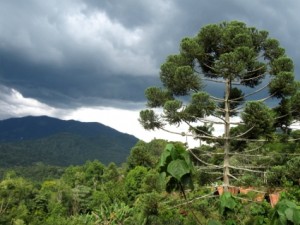
Photo © Michael Sommers.
One of the things I was most looking forward to seeing when I made my recent trip to the Serra da Mantiqueira was the rare and unusual araucaria tree. A native of the mountains and high planes of southern Brazil, the araucaria angustifolia (to go by its full official name) is a species of coniferous tree that dates back some 2 million years – and it looks it (i.e. decidedly primitive).
This evergreen is actually only a distant relative of the pine, yet it’s often referred to as a pinheiro brasileiro (Brazilian pine), and more frequently as a pinheiro-do-paraná (Paraná pine). Indeed, the highly iconic tree is the emblem of the southern state of Paraná, where forests of araucaria once covered close to 50 percent of the land. Due to agriculture and foresting, today they have dwindled to around 2 percent. Nonetheless Paraná still boasts more of the evergreens than its neighbors to the south and north (in Rio, São Paulo, and Minas Gerais they’re particularly scarce), which explains why the species is now threatened with extinction.
Two English names for the araucaria – the Candelabra tree and Monkey Puzzle tree – are descriptively apt.A far cry from 6,000 years ago when the indigenous peoples of southern Brazil depended on the enormous pine nuts generated by the trees for sustenance. Back then, araucarias were so plentiful that the word curitiba was coined to describe “an immense area of curis,” the Guarani term for Paraná pine (underscoring the tree’s importance is the fact that Curitiba was chosen as the name for the capital of Paraná). Local Guarani groups even developed special arrows designed to shoot down pine-nut bearing fruit that hadn’t yet fallen to the ground.
Araucaria nuts – enormous, they resemble conventional pine nuts on steroids – are major energy boosters. High in protein, calcium, and other vitamins, they are used both regional and contemporary dishes ranging from pies to pesto. In Campos do Jordão’s fancy gourmet food shops, we saw them marinating in great jars.
As for the trees themselves, they didn’t disappoint. Whether singly or in bouquet-like clumps, their slender trunks (which grow to heights of 50 meters), topped with lateral branches that extend horizontally into a parasol of twisting green arms, are captivating. In fact, two English names for the araucaria – the Candelabra tree and Monkey Puzzle tree – are descriptively apt. The origin of the latter followed soon after the tree was introduced to England in the late 18th century. A visitor to a proud araucaria owner’s Cornwall garden exclaimed that its branches were so whorled and twisted that navigating them would “puzzle a monkey.”
Most trees live to the ripe old age of 200 years or more; it takes them 20 to begin bearing fruit and 50 to emerge from adolescence. Unlike most conifers, which are hermaphrodites, araucarias come in both male and female versions (although some have been known to change sex over the course of their lifetimes). While the female trees have the oval cones that bear fruit – each can contain up to 120 seeds or nuts – the males sport twisting, cylindrical-shaped cones, which make great fire starters in hotel fireplaces.
Their flammability was put to the test when my sister and I spent a night at the Pousada Vento Verde, whose comfortably rustic bungalows sit upon a mountain slope and provide a breathtaking view of the pretty little town of Santo Antônio do Pinhal surrounded by magnificent forest-clad mountains. Santo Antônio is the anti-Campos Jordão; an unpretentiously, charming, typical town of the interior, plunged into a forested valley, and quite overlooked by most tourists. In keeping with its name (Saint Anthony of the Pine Groves), araucarias are everywhere. One of the most majestic of them all is pictured above; I have to confess that it constitutes only one of about 100 or more photos I ended up (obsessively) taking of these striking trees.